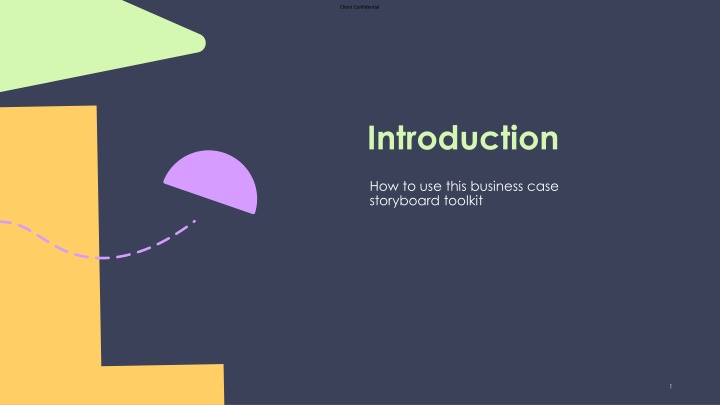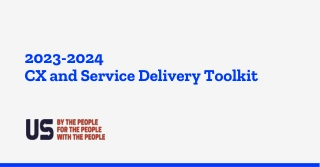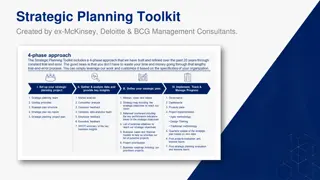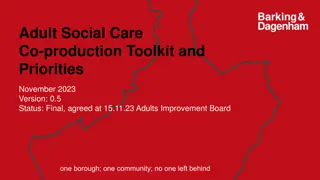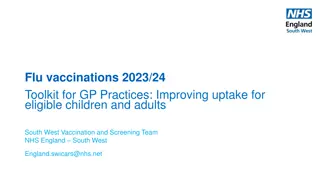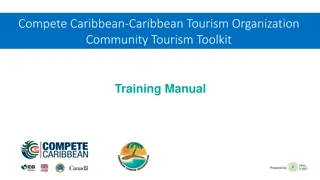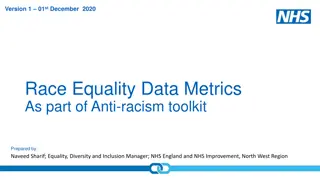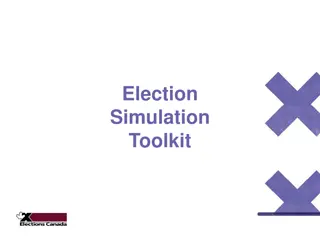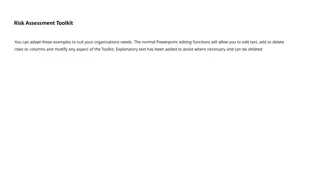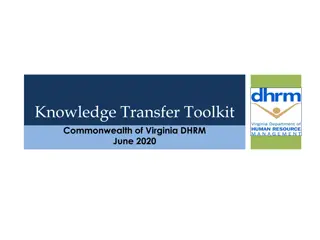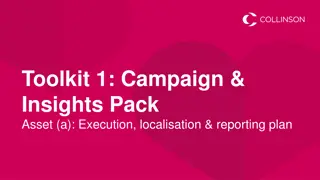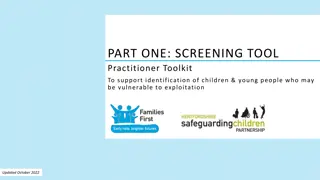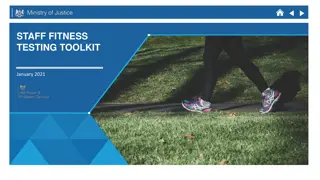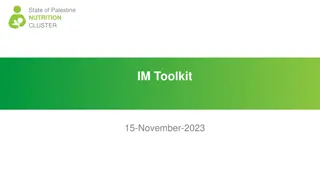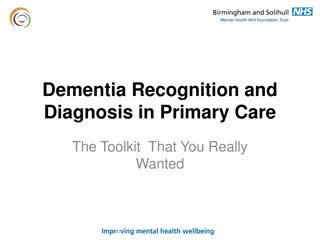Business Case Storyboard Toolkit
A detailed toolkit for creating a business case storyboard, including sections on strategic purpose, tools, outcomes, benefits, costs, and more. This toolkit provides a structured approach to developing a comprehensive business case for projects.
Download Presentation

Please find below an Image/Link to download the presentation.
The content on the website is provided AS IS for your information and personal use only. It may not be sold, licensed, or shared on other websites without obtaining consent from the author.If you encounter any issues during the download, it is possible that the publisher has removed the file from their server.
You are allowed to download the files provided on this website for personal or commercial use, subject to the condition that they are used lawfully. All files are the property of their respective owners.
The content on the website is provided AS IS for your information and personal use only. It may not be sold, licensed, or shared on other websites without obtaining consent from the author.
E N D
Presentation Transcript
Client Confidential Introduction How to use this business case storyboard toolkit 1
Client Confidential A storyboard is a technique used to visualise different scenarios and plan business activities. Storyboarding can be a valuable tool for communicating, collaborating, and planning effectively, making it easier for stakeholders to see how you've developed the thinking behind your business case and picture the outcome. It can also be used as a drafting tool as you develop your formal proposal. How to use this storyboard This editable document is to be used as a starting point to storyboard the key parts of your business case for your housing stock retrofit project Each section of this presentation provides a key question that the section should answer Within each section, a breakdown of the key requirements is listed so that the business case is informative for decision making. This also includes some key examples of what to include Leading headers and questions throughout the sections will help form a checklist of the information required to form the business case and critically analyse the content you are delivering to aid success The appendices includes a further glossary of terms, and background to the information required within each section A more detailed version of the information included can be found here: business case toolkit 2
Client Confidential Business Case Toolkit: Storyboard Funded by Delivered by
Client Confidential Contents Strategic Purpose Tools and Resources Target Outcome Benefits Retrofit Actions Costs Financing Resources Procurement Strategy Risk management Appendices: Glossary 4
Client Confidential Framework A complete business case brings together a great deal of information from different teams and different sources. There are many questions to answer, and it is often easy to lose the strategic overview amongst all the detail. This framework provides all the topics covered in a business case in individual blocks. Each block has its own series of detailed questions and actions, but the single page overview supports monitoring the business case development. Strategic Purpose Retrofit Actions Resources Costs Outcome Procureme nt Delivery Plan Financing Benefits Risk Management 5
Client Confidential WHY? First is the WHY? The Strategic Purpose of the project shows how it aligns with the goals of the organisation. It explains why the project is important. This will define the specific goals of your organisation and the external trends and drivers to show why the project is necessary. Strategic Purpose Retrofit Actions Resources Costs Outcome Procurement Financing Delivery Plan Benefits Risk Management 6
Client Confidential WHAT? Second is the WHAT? This defined the project targets and outcomes for what will take place and what benefit it will have if delivered successfully. Strategic Purpose Retrofit Actions Resources Costs Outcome Procurement Financing Delivery Plan Benefits Risk Management 7
Client Confidential HOW? Finally the HOW? This includes what will take place to deliver the project to budgeted cost and on time, taking into account risks and mitigations. Strategic Purpose Retrofit Actions Costs Resources Outcome Benefits Financing Procurement Delivery Plan Risk Management 8
Client Confidential Strategic Purpose Why is the project important to the organisation? 9
Client Confidential How does the project advance the strategy goals? What are the public commitments we have made that this will support? How will this support a good reputation? Alignment to regulations and requirements? Alignment to trends and drivers? Challenges and objectives for the senior management? Strategic Purpose Map your project to these strategic goals and imperatives Review sources of organisational strategic goals and imperatives: Organisation strategy statements e.g. The Social Housing Group already has a target to be net zero by 2040. How will your project deliver the goals? External trends and drivers e.g. Social Housing Group's internal research shows that the cost of living crisis is putting more of our residents at risk of fuel poverty. Specific goals of key departments, functions and decision-makers e.g., mapping key stakeholders such as the LA planning department Page 11 of Toolkit 10
Client Confidential Target Outcomes What will the project deliver? 11
Client Confidential Target outcomes What performance do you expect from the properties after retrofit? What metrics are you using? Property data, consensus data etc. Can you provide this in clear and concise statements? Are your target outcomes driven by government policy and your organisation s corporate strategy? What other social and economic objectives are included? State the desired outcome clearly and simply - What are the economic targets? e.g., justification to funders. - What are the social and health targets? e,.g., air quality etc. Economic and social objectives: UK Reduction in fuel poverty: Government s Sustainable Warmth strategy. Resident health improvements: International Energy Agency (IEA) on Multiple Benefits of Energy Efficiency Health and Wellbeing Local job creation: In Regeneration and Retrofit, the UK Green Building Council (UKGBC) - What are the technical targets that are aligned to PAS2035? e,.g. We will improve these 100 properties from an average EPC rating of E to C, cutting fuel poverty rates for residents by 30% Page 15 of Toolkit 12
Client Confidential Benefits What are the key benefits of a successful project? 13
Client Confidential Benefits What performance do you expect from the properties after retrofit? Can you provide this in clear and concise statements? Are your target outcomes driven by government policy and your organisation s corporate strategy? What other social and economic objectives are included? State the desired outcome clearly and simply - Include social and health outcomes in your target e.g., , lower healthcare costs through a reduction in fuel poverty - Explore possible economic outcome targets e.g., reduced energy bills or increased economic activity - Ensure your project s retrofit measure outcomes align with PAS 2035 e.g., Fabric first approaches that minimise heat loss. Page 17 of Toolkit
Client Confidential Retrofit Actions What retrofits will you apply to the target dwellings? 15
Client Confidential Retrofit Actions Can you compile a list of the energy efficiency and other measures you intend to apply to the target properties? Can the list include realistic estimation of costs? Does outcome of the measures and the process of their installation align with wider strategic objectives? How have you mapped of any stakeholders that are needed to install the intended measures, such as the local planning authority and the District Network Organisation? Describe how you will deliver outcomes - Include target outcomes, stock analysis and dwelling selection, modelling software used for detailed design and financing and other constraints e.g., property archetype mapping. - Other actions ahead of retrofit: delivery plan, cost, resources planning and risk management e.g., understand electricity capacity and site access. Try the retrofit project overview to support your case. -Map of stakeholders required, showing influence and interest, and value proposition e.g., board members, contractors, DNO Page 18 of Toolkit
Client Confidential Delivery Plan How will you deliver the project and are you clear on the tasks, milestones and sequencing? 17
Client Confidential Delivery Plan Can it be delivered in the time available? Where are the bottlenecks? Where are the biggest risks? How could the project be delivered faster? What are the Implications for resource requirements and costs? Breakdown of the project to the individual tasks, their duration and timings - Gantt chart of sequence - Accountability of various tasks e.g., PAS 2035 retrofit coordinator. -Project management approach of requirements and risks e.g., what is your organisation s standard approach? -Resource securing and team forming e.g., mapping of existing resources and expectation of tasks and roles. Page 21 of Toolkit
Client Confidential Costs What will the project cost to deliver? 19
Client Confidential Identify the buildings that will be upgraded, and the energy efficiency and other measures that you will apply to each Resources of internal and external, that will be required to deliver the project? Estimate costs for each task Consider constraints with cost implications, such as milestone dates and availability of resources Assess any risk associated with cost increases and add to the risk register Costs Estimates of project costs with improved costing for investments - Accurate investments and costing plan: CapEx (capital expenditure), OpEx (operational expenditure), ROI (return on investment) - How are the costs defined? Action, delivery plan, and resource allocation. e.g., quotes and cost database access - What are the costs influenced by? Procurement, risk and financing options. e.g., option appraisal for finance and procurement. -Sources of cost information and models of delivery of costing. e.g., software tools and review/model types such as Analogous review, Parametric models and Bottom up Estimating. Page 21 of Toolkit
Client Confidential Financing Where will the money for the project come form? 21
Client Confidential Have the financing requirements been clearly identified? What is the amount of financing required? If public sector funding is available, what percentage of the estimated project costs does it cover? Which are the preferred sources of finance for this project? Has financing been secured? Are financing risks included in the risk register? Financing Options for providing finance? - Accurate investments and costing plan: CapEx (capital expenditure), OpEx (operational expenditure), ROI (return on investment) - What internal finance is available? This could be a surplus or an annual budget that can lever grant funding, such as an annual maintenance budget - What commercial loans and corporate bonds are available? e.g., Environmental Finance report Sustainable Bonds Insight 2021 -Grants, either governmental or non-governmental e.g., Social housing decarbonisation fund. Page 24 of Toolkit
Client Confidential Resourcing What are the resource requirements to deliver the project and where will you get it from? 23
Client Confidential Undertake an organisational retrofit skills gap assessment Consider whether you have time to acquire any necessary skills Identify suppliers according to the project s needs Highlight missing resources, especially where they impact compliance Resourcing Internal and external resource requirements e.g., what do I need to build a team - Identification of internal resource that covers jobs required e.g., different departments within your organisation - What can we train staff internally to meet requirements? e.g., identification of special skills -What do we need to recruit for? e.g., PAS 2035 roles and gaps in resources. Page 25 of Toolkit
Client Confidential Procurement Strategy How can the procurement strategy support the projects aims and objectives? 25
Client Confidential Procurement Strategy Identify the organisation s existing procurement strategy Ensure the procurement team understands the project s aims and objectives Include procurement risks on the risk register Consider whether your procurement approach promotes sustainable development practices Choose a procurement method Pocurement principles - key principles of good procurement in the UK public sector e.g., Procurement should be through competition and ctivity should align with legislation and other obligations - Additional benefits to procurement e.g., Economic UK drivers and sustainable development goal aligned. -Method for procurement e.g., strategy for supplier engagement, tender completion timeline etc. Page 28 of Toolkit
Client Confidential Risk Management What are the most significant risks for the project and how can we mitigate them? 27
Client Confidential Establish a documented risk management process with named people accountable Create a project risk register that highlights the greatest risks Mitigate priority risks Share the risk register and mitigation with key partners, such as consortium members and suppliers Regularly review and update the risk register Establish a process for adding new risks to the register Risk Management How, who and when will the risk management be assessed. -What are the typical risks for a project of this nature? e.g., approval timelines, design risk, installation backlog. -How will you conduct risk analysis? -What processes are in place to review risk? e.g., Regular project meetings and risk register -What is the approach for mitigation? e.g., Discussion with key stakeholder, track of delivery timeline. Page 30 of Toolkit
Client Confidential Appendicies 29
Client Confidential Purpose Activity Questions Relevance Why Strategic Purpose Why is this project important? How does it support corporate strategic objectives? Does it respond to significant external drivers? E.g. regulatory, financial, environmental, social objectives? Discuss the significance of the project and its potential to achieve organisational goals, such as net zero by a certain date, reductions in fuel poverty and support to local agendas. Reputation management and external drivers for public expectation or market leading may also support your case here. What? Target Outcomes What is the target outcome? What is the goal? What does success look like? Set the social and economic objectives of the project. This can either focus on the housing portfolio data e.g., We will improve 150 properties from an EPC rating E to C . And stating what this will achieve e.g., a fuel saving or an alignment to recognised standards. Benefits If you deliver the outcomes, what benefits will follow? What benefits to the organisation? What benefits to customers? What benefits to wider society? What is the value of these benefits? Consider the direct and indirect benefits, as well as quantitative and qualitative benefits. Benefits need to be valued against the projected costs and risk to ensure the project is viable. Calculation of the benefits can be based off materials such as The Green Book. Retrofit Actions What retrofit interventions to the target group of properties will deliver the desired outcome? Retrofit actions are not decided within the business case process. What is required for the business case is a list of the planned interventions for specific properties. Executing a draft or a final list will mean reliability and range of any cost estimates will vary with the confidence you have in the planned retrofit interventions. Bare this in mind when presenting your options. How? Delivery Plan How will you organise to deliver the retrofit actions on time and in budget? Gantt chart or other project plan. The delivery plan breaks down the project to the individual tasks, their duration and timing. A Gantt chart is a popular tool for showing task dependencies, durations, and timing. Consider the resource implications and how this may affect key milestones. Costs and Financing What are the costs of delivering the planned retrofit actions? List the various sources of financing for the delivery plan. Your costs are defined by the technical outputs that you hope to deliver. This will then filter the tasks, resources and risk associated with these measures which can be modelled using various techniques. To finance the project, various support streams exist that your delivery plan will need to account for. Resources What resources (internal and external) are required and how will they be sourced? Additional roles and tasks are defined as part of the PAS2035 roles and additional roles more specific to your organisation could be introduced, which may require upskilling or training. Procurement What procurement approach will you use? Strategy and principles for procurement should be clearly defined with good organisation practice employed. Procurement choices should enhance your companies values e.g., social community value, positive environmental impact and human rights. Risk Management What are the key risks to the project? How will you mitigate these risks? Who is responsible for managing these risks? Risk management extends beyond the formal completion of the project. There is little point in delivering a retrofit project on time and in budget if problems still occur. The risk management process consists of the policies, framework, processes and rules that you need to identify, assess and mitigate. Page 36 of Toolkit
Client Confidential Funded by Delivered by
